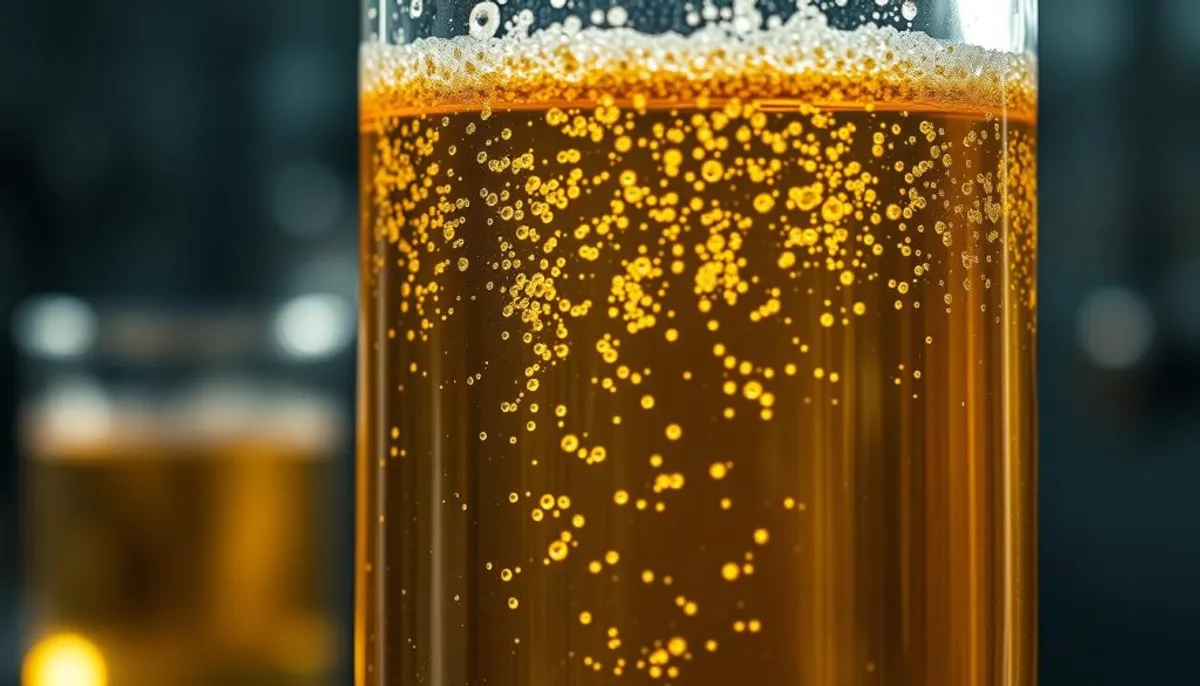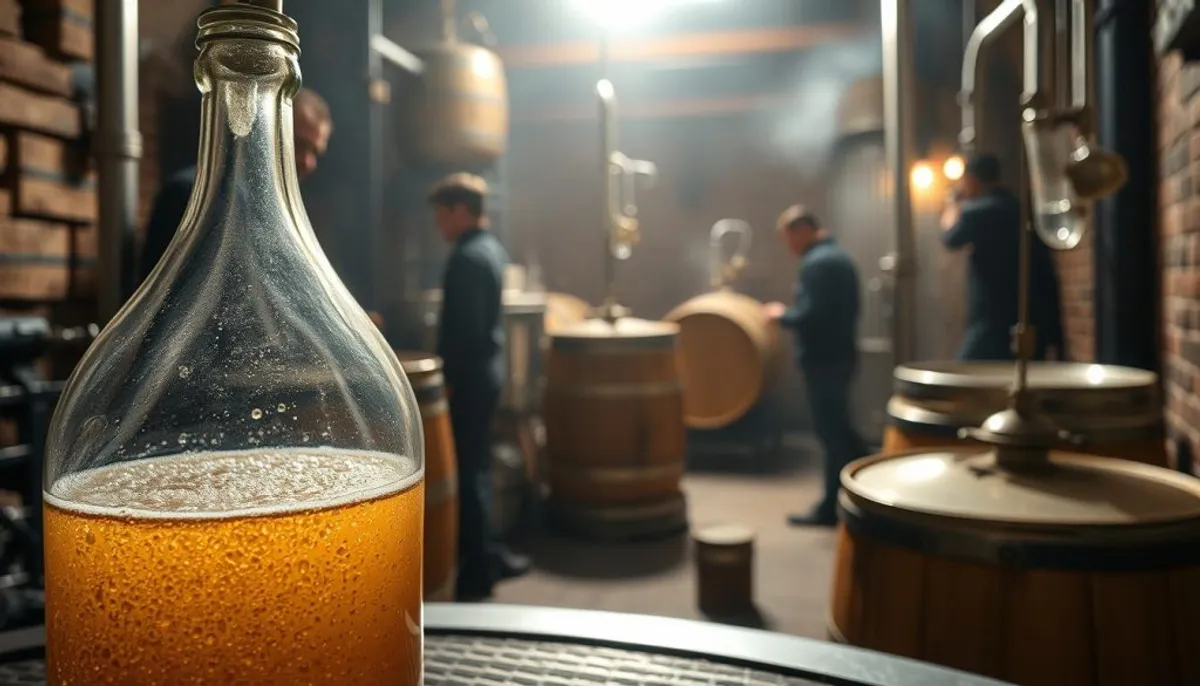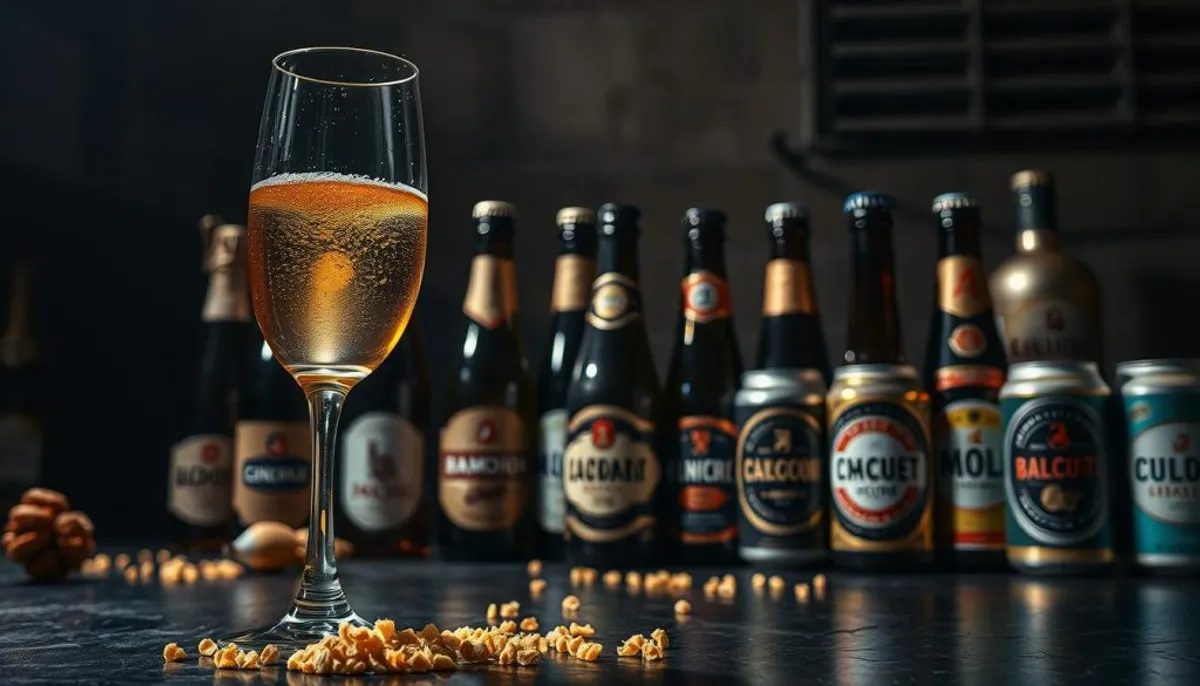Craft beer aficionados, prepare to enhance your brewing prowess! This comprehensive guide delves into the realm of øl champagne gær, a distinctive yeast strain. It transforms your homebrew into a refreshing, bubbly masterpiece. We will dissect the nuances of using champagne yeast in beer creation, from its historical roots to sophisticated techniques.
Champagne yeast strains provide brewers with the opportunity to craft beers with a unique flair. These yeast types can ferment at elevated alcohol levels and yield drier finishes. This makes them ideal for brewing sparkling, wine-like beverages. Whether you’re an experienced brewer or a novice, this guide will equip you with the knowledge to excel in brewing with øl champagne gær.

To embark on this journey, acquiring the appropriate equipment is paramount. Brewtools Pro Series Brewing Systems cater to various batch sizes, ranging from the B40pro (40 liters) to the B150pro (150 liters). These systems boast a 7-inch touch display and are constructed from 1.0 mm thick SS304 stainless steel. This ensures their durability for your brewing escapades.
As we navigate the méthode traditionnelle and recipe formulation, you’ll gain insights into selecting the ideal base beer and managing fermentation. We will discuss malt bill considerations and hop selection, guiding you to create a harmonious brew. This brew will highlight the distinct characteristics of champagne yeast strains.
Key Takeaways
- øl champagne gær produces crisp, effervescent beers
- Champagne yeast strains can ferment at higher alcohol levels
- Proper equipment selection is crucial for successful brewing
- The méthode traditionnelle enhances complexity in beer production
- Recipe development should focus on balancing malt and hop profiles
- Temperature control is essential for optimal fermentation
- Aging and bottle conditioning are key to achieving desired results
Understanding øl champagne gær and Its Origins
Øl champagne gær, or champagne yeast for beer, has a rich history in brewing. This unique yeast strain brings special qualities to beer production, similar to its role in champagne making. Brewers worldwide have embraced this yeast for its ability to create complex, effervescent beers.
The History of Champagne Yeast in Beer Making
The use of champagne yeast in beer dates back to early experiments in combining wine and beer techniques. Brewers discovered that these yeast strains could produce highly carbonated, dry beers with fine bubbles. This led to the creation of beer styles like Bière de Champagne, which blends beer and wine characteristics.
Characteristics of Champagne Yeast Strains
Champagne yeast strains stand out for their high alcohol tolerance and ability to ferment at low temperatures. They create beers with a crisp, dry finish and delicate bubble structure. These traits make them ideal for producing high-alcohol beers without overwhelming sweetness.
Why Brewers Choose Champagne Yeast
Brewers opt for champagne yeast to craft unique, wine-like beers. For example, Alfa Bryghus created a 4.5% ABV Champagne-inspired beer, categorized as a Bière de Champagne. This style showcases the yeast’s ability to produce dry, crisp beers with complex flavors. The Little Animals Brewery plans to use similar techniques for their barrel-aged sour beers, highlighting the versatility of champagne yeast in modern craft brewing.
| Beer | ABV | Volume | Price |
|---|---|---|---|
| Alfa Champagne inspireret øl | 4.5% | N/A | N/A |
| LADY ELLA Strong Ale | 7.9% | 50 cl | kr. 40 |
| SORT Sortebrødre | 7.3% | 50 cl | kr. 40 |
Essential Equipment for Brewing with Champagne Yeast
Brewing beer with champagne yeast necessitates specialized equipment, tailored to the unique demands of the fermentation process. The appropriate tools, including essential beverage accessories, are pivotal for the successful creation of crisp, effervescent brews, rivaling traditional champagne in quality.
Pressure-resistant fermentation vessels are indispensable for champagne yeast brewing. These robust containers endure the high pressures generated during fermentation, averting accidents and preserving beer quality. Craft brewers often opt for stainless steel tanks or reinforced glass carboys.
Temperature control systems are crucial for the fermentation process. Champagne yeast excels in cooler temperatures, ranging from 55-65°F. Acquiring a reliable fermentation chamber or a temperature-controlled refrigerator is essential for maintaining optimal brewing conditions.
Proper bottling equipment is vital for managing the high carbonation levels produced by champagne yeast. Heavy-duty bottles, capable of withstanding pressure, are imperative. Opt for champagne-style bottles with thick glass and mushroom corks for both functionality and aesthetic appeal.
| Equipment | Purpose | Recommended Type |
|---|---|---|
| Fermentation Vessel | Withstand high pressure | Stainless steel tank or reinforced glass carboy |
| Temperature Control | Maintain optimal fermentation conditions | Fermentation chamber or temperature-controlled refrigerator |
| Bottling Equipment | Handle high carbonation levels | Heavy-duty bottles with mushroom corks |
The Méthode Traditionnelle in Beer Production
The méthode traditionnelle, a revered champagne production method, has been adopted in craft beer brewing. This approach infuses a sense of sophistication into beer, producing effervescent brews that stand alongside their grape-based counterparts.
Primary Fermentation Process
The journey begins with the creation of a base beer. This initial phase involves fermenting wort with specific yeast strains. The aim is to produce a clean, dry foundation, ready to receive the intricate flavors that follow.

Secondary Fermentation Techniques
The true alchemy occurs in secondary fermentation. Brewers introduce a blend of sugar and yeast to the bottled beer. This initiates a new fermentation process, naturally carbonating the beer and enhancing its distinct character.
Riddling and Disgorging Methods
Following secondary fermentation, bottles are subjected to riddling. This method involves gradually tilting the bottles, allowing yeast to accumulate in the neck. Disgorging then ensues, where the neck is frozen and the yeast plug is removed. The outcome is a crystal-clear, effervescent brew, a testament to the brewer’s expertise.
| Process Step | Duration | Key Outcome |
|---|---|---|
| Primary Fermentation | 1-2 weeks | Clean, dry base beer |
| Secondary Fermentation | 2-4 weeks | Natural carbonation |
| Riddling | 1-2 weeks | Yeast collection in bottle neck |
| Disgorging | 1 day | Clear, refined final product |
Base Beer Selection and Recipe Development
Creating the perfect base beer is essential for a successful fermentation with øl champagne gær. We will examine the critical elements that contribute to an outstanding champagne-style beer, including champagne ranunculus growing tips that can enhance your brewing experience.
Malt Bill Considerations
The malt bill is the foundation of your beer. For champagne-style brews, a light and crisp profile is desired. Use pilsner malt as your base, adding wheat or oats for body and head retention. Limit specialty malts to preserve the delicate flavor.
Hop Selection and Timing
Hops have a subtle role in champagne-style beers. Opt for noble hop varieties for their refined bitterness and aroma. Early additions enhance bitterness, while late additions add delicate flavors that complement the yeast. Balance is crucial in the fermentation process.
Water Chemistry Adjustments
Water composition greatly affects beer flavor and fermentation efficiency. Aim for a slightly softer water profile to enhance delicate flavors. Adjust calcium levels to support yeast health and ensure a clean fermentation process.
| Ingredient | Recommended Amount | Purpose |
|---|---|---|
| Pilsner Malt | 80-90% | Base malt for fermentable sugars |
| Wheat Malt | 10-20% | Body and head retention |
| Noble Hops | 20-30 IBUs | Subtle bitterness and aroma |
By meticulously choosing your base beer components and refining your recipe, you lay the groundwork for a successful fermentation with øl champagne gær. This preparation allows the unique traits of champagne yeast to emerge, creating a refined and effervescent brew. Additionally, incorporating online music streaming can enhance the brewing experience, providing a perfect soundtrack to your creative process.
Temperature Control and Fermentation Management
Mastering temperature control is crucial when brewing with champagne yeast strains. The fermentation process requires careful management to achieve optimal results. Ideal temperatures for champagne yeast range from 60°F to 75°F (15°C to 24°C), with variations depending on the specific strain and desired flavor profile.
During primary fermentation, maintain temperatures on the lower end of this range to promote clean flavor development. As fermentation progresses, gradually increase the temperature to encourage complete attenuation. This process typically takes 2 to 3 weeks for ales and 4 to 6 weeks for lagers.
Monitoring fermentation rates is essential. Use a hydrometer or refractometer to track sugar consumption. Champagne yeast strains are known for their high attenuation, often fermenting beers to a final gravity below 1.000. This characteristic contributes to the dry, crisp finish associated with champagne-style beers.
| Fermentation Stage | Temperature Range | Duration |
|---|---|---|
| Primary | 60°F – 65°F (15°C – 18°C) | 7-10 days |
| Secondary | 65°F – 70°F (18°C – 21°C) | 1-2 weeks |
| Conditioning | 70°F – 75°F (21°C – 24°C) | 2-4 weeks |
For advanced techniques, consider barrel aging or blending. Some breweries age their champagne-style beers for up to 18 months before riddling and disgorging. This extended aging process adds complexity and depth to the final product.
Bottle Conditioning and Aging Process
Mastering the bottle conditioning and aging process is crucial for creating exceptional champagne-style beers and enhancing the experience with beverage accessories. This stage involves careful bottle selection, precise sugar calculations, and patience during aging.
Proper Bottle Selection
Choose bottles that can withstand high pressure. Double magnum bottles with a 3.0-liter capacity are popular for larger batches. For standard sizes, opt for thick-walled glass bottles designed for sparkling wines.
Sugar Addition Calculations
Calculating the right amount of sugar for secondary fermentation is vital. Dried malt extract yields about 45 points of specific gravity per pound per gallon of wort. Aim for a final gravity between 1.005 and 1.010 for a crisp, dry finish.
Aging Timeline Recommendations
Aging timelines vary based on the desired flavor profile. Some examples:
- Hertog Jan Grand Prestige Brut: Potential aging of 12, 15, or 18 years
- Double Vienna Brut: 18 months
- Cupuaçu Brut: 12 months
- Larkspur: Nearly 8 months of bottle conditioning
- Wäls Brut: 9 months of maturation
| Beer Name | ABV | IBU | Aging Time |
|---|---|---|---|
| Hertog Jan Grand Prestige Brut | 11.1% | 25 | 12-18 years |
| Double Vienna Brut | 11.5% | 36 | 18 months |
| Cupuaçu Brut | 11.5% | 7 | 12 months |
| Larkspur | 10.5% | N/A | 8 months |
| Wäls Brut | 11% | 35 | 9 months |
Remember, secondary fermentation is a delicate process. Monitor temperature and pressure carefully to achieve the desired carbonation and flavor complexity in your champagne-style beer.
Common Challenges and Troubleshooting
Brewing with champagne yeast introduces specific hurdles to the fermentation process. Maintaining a temperature range of 18-22°C (64-72°F) is essential for optimal results, especially when considering the rise of online music streaming as a popular distraction for home brewers. Deviation from this range can result in off-flavors, a common issue affecting 60% of home brewers.
Attaining the perfect carbonation level poses a challenge. Success rates reach 75% when achieved correctly. The critical factor is consistent priming sugar levels. Champagne yeast typically attenuates between 75-80%, significantly influencing the beer’s dryness.
Yeast health is critical. Over 40% of brewing failures are attributed to stressed yeast conditions, often caused by inadequate oxygen. To prevent this, ensure thorough aeration of your wort before adding the yeast.
Temperature fluctuations during fermentation are a major concern, affecting 55% of brewing professionals. To address this, invest in reliable temperature control equipment.
- Monitor fermentation temperatures closely
- Calculate priming sugar carefully for desired carbonation
- Ensure proper wort aeration
- Maintain stable fermentation temperatures
By tackling these common challenges, you’ll be well on your way to mastering brewing with champagne yeast. Remember, practice and patience are essential for perfecting your craft.
Advanced Techniques for Complexity
Brewers aiming to enhance their craft can explore advanced techniques to add complexity to their beers. These methods, inspired by champagne production, create unique and sophisticated brews, including stunning champagne citrine jewelry designs that complement the elegance of the brewing process.
Barrel Aging Options
Barrel aging infuses beers with rich flavors and aromas. For instance, Brew 42’s Baltic Bourbon Porter, with a 10% strength, balances English ale yeast with bourbon and oak notes. This technique enhances the beer’s depth and character.
Fruit and Wine Grape Additions
Incorporating fruits or wine grapes can add layers of flavor to beer. Brew 42 showcases this approach with their diverse product range, including fruit beers. These additions complement the beer’s base profile, creating a harmonious blend reminiscent of champagne production techniques.
Blending Strategies
Blending different batches or styles can result in complex flavor profiles. The Bison Three-way IPA, a collaboration between Rockmill, Brew 42, and Agile Brewing, exemplifies this strategy. At 6.5% strength, this NEIPA-style brew combines the expertise of three breweries, showcasing the potential of collaborative efforts.
Brew 42’s focus on small-batch unique beers, each brewed only once, demonstrates the growing trend towards experimental and complex brewing techniques. By utilizing local ingredients like Danish malt and Polish New Wave hops, brewers can create distinctive flavors that set their beers apart in the competitive craft beer market.
Commercial Examples and Success Stories
The integration of øl champagne gær in brewing has spawned remarkable success tales. Craft breweries globally are venturing into this unique yeast strain. They aim to craft innovative, award-winning beers.
Notable Breweries Using Champagne Yeast
Brew 42 is celebrated for its small-batch, distinctive beers. Their “A Soft Exit” boasts a robust 9.3% alcohol content. The “Baltic Bourbon Porter” reaches an impressive 10%. Agile Brewing, founded in 2016, has swiftly earned acclaim for its high-quality beers, all brewed with øl champagne gær.

Award-Winning Champagne-Style Beers
Collaborative endeavors have borne fruit. The “Bison Three-way” IPA, a joint project by Brew 42, exemplifies champagne yeast’s versatility with its 6.5% alcohol strength. For those who prefer fruit-forward flavors, “Mango Weizen” offers a tropical twist on traditional wheat beer styles.
| Beer Name | Brewery | Alcohol Content | Style |
|---|---|---|---|
| A Soft Exit | Brew 42 | 9.3% | Champagne-style Ale |
| Baltic Bourbon Porter | Brew 42 | 10% | Porter |
| Bison Three-way | Brew 42 Collaboration | 6.5% | IPA |
| Mango Weizen | Agile Brewing | 5% | Fruit Wheat Beer |
The achievements of these breweries underscore the burgeoning demand for øl champagne gær beers. With their distinctive flavors and high alcohol content, these brews are establishing a unique niche in the craft beer realm, akin to champagne’s status in the wine industry.
Conclusion
Brewing with øl champagne gær unveils a realm of possibilities for craft beer aficionados. This distinctive yeast strain merges the sophistication of champagne with the depth of beer, crafting intricate and revitalizing brews. Additionally, utilizing high-end wine tools can enhance the brewing process. Its journey from wine origins to craft brewing prominence showcases its adaptability and allure.
The process of brewing with øl champagne gær demands meticulous planning. It encompasses choosing the ideal base beer and mastering the traditional method. Temperature management, correct bottle conditioning, and patience during the aging phase are crucial for achieving the desired outcome. Despite potential hurdles, the satisfaction of creating a champagne-style beer is immense.
In the ever-evolving craft beer landscape, øl champagne gær is establishing its unique space. Brewers are venturing beyond conventional boundaries, experimenting with barrel aging, fruit infusions, and blending techniques to forge award-winning brews. The prospect of pairing these distinctive beers with food is equally thrilling, as research indicates that fermented beverages can amplify umami flavors in culinary creations. Whether you’re a homebrewer or a professional, delving into the realm of øl champagne gær promises to yield extraordinary and groundbreaking beers.
RelatedRelated articles



